Harnessing Bleach for Superior Grout Cleaning
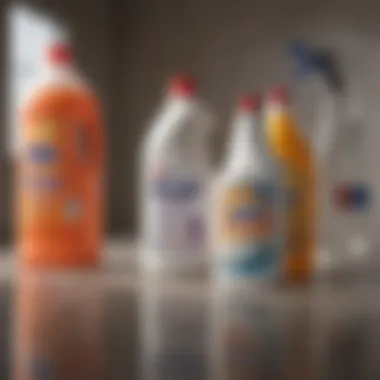
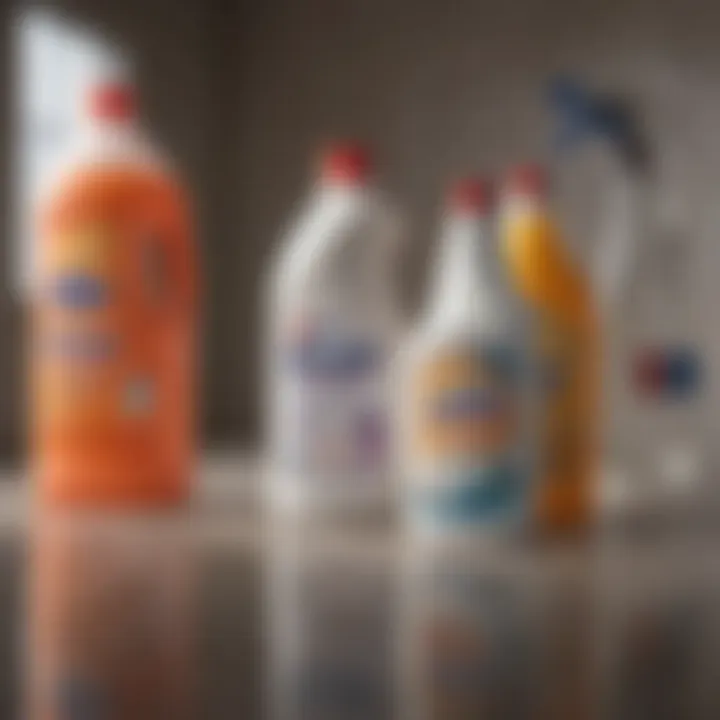
Intro
Grout accumulates dirt and stains over time, leading to a neglected appearance in tiled spaces. Many household cleaners are available, but bleach stands out due to its strong staining and disinfectant properties. This article will explore how to safely utilize bleach for effective grout cleaning. We will examine safe preparation methods, application techniques, and precautions necessary to make the process safe and effective.
Understanding Bleach's Functionality
Bleach, commonly sodium hypochlorite, has unique chemical properties that make it suitable for cleaning. It works by breaking down the chemical bonds within the stains, resulting in a lighter appearance on surfaces. Its ability to disinfect also helps reduce mold and mildew growth, common concerns in moist areas such as bathrooms.
While bleach is effective, understanding its limitations is crucial. It is not suitable for all grout types. Additionally, it can cause fading in certain tile finishes or damage to surfaces if not used properly.
Safety Precautions
Using bleach comes with its own risks. Proper ventilation is essential when using bleach to prevent inhalation of fumes. Here are specific safety measures to consider:
- Always wear gloves to protect your skin.
- Use eye protection to avoid irritation.
- Ensure the area is well-ventilated by opening windows or using fans.
- Store bleach in a safe place away from children and pets.
"Safety should always be the priority when using cleaning products like bleach."
Additionally, avoid mixing bleach with ammonia or other cleaners, as this combination can create toxic gases.
Preparing Bleach Solution
Preparing a bleach solution is straightforward. Consider these steps for effective cleaning:
- Start with a ratio of one part bleach to ten parts water. This dilution is effective and minimizes risks.
- Mix the solution in a well-ventilated area, preferably outdoors.
- Utilize a bucket for mixing to avoid spills.
Label the solution clearly to prevent accidental misuse. Always wear gloves when handling the prepared bleach solution.
Application Techniques
To apply bleach to grout, follow these steps:
- Ensure the grout is dry before application. Wet grout can dilute the bleach's effectiveness.
- Use a toothbrush or a scrub brush to apply the solution, working it into the grout lines.
- Allow the solution to sit for 10-15 minutes to effectively penetrate and lift stains.
- Rinse thoroughly with water after scrubbing to remove bleach residue.
It's important not to allow the bleach to sit too long, as it might damage the grout or tile material.
Alternatives to Bleach
While bleach is an effective option, there are alternatives for those looking to avoid harsh chemicals. Consider the following:
- Vinegar: An effective natural cleaner, especially against mildew and soap scum.
- Baking Soda: Useful when combined with water or vinegar for deeper scrubbing.
- Commercial Grout Cleaners: Formulated specifically for grout, often containing milder yet effective ingredients.
Each alternative has its unique application method and effectiveness, but they tend to be less harsh than bleach.
Maintaining Clean Grout
After successfully cleaning grout, consider maintenance techniques to prolong cleanliness:
- Regularly clean tiles with mild soap to prevent buildup.
- Use a sealant on grout after cleaning to provide a barrier against stains and moisture.
- Wipe down surfaces frequently in moisture-prone areas.
By adhering to these practices, you can sustain a clean and healthy appearance for your grout, minimizing future deep cleans.
Epilogue
Preface to Grout Cleaning
Grout cleaning is crucial for maintaining the aesthetic and functional aspects of tiled surfaces. Grout, often neglected, can accumulate dirt, mold, and mildew, which can lead to a significant decline in a home's overall appearance. Understanding grout cleaning is not only about keeping it looking fresh but also about preserving the integrity of the tiles themselves.
Understanding Grout Composition
Grout is a mixture primarily composed of water, cement, and sand. There are different types of grout, such as unsanded and sanded, depending on the specific use case. Unsanded grout is typically used for internal installations and thinner joints, while sanded grout is suitable for wider joints and external applications. The composition impacts its susceptibility to stains and changes over time.
The cement in grout makes it a porous material. This porosity allows it to absorb stains and moisture, which can contribute to the growth of bacteria and fungi. Moreover, the color of the grout can indicate the type of cleaning and maintenance routine that may be necessary. Light-colored grout, for instance, often requires more attention than darker shades due to visibility of stains.
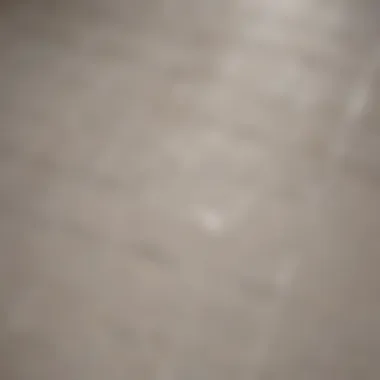
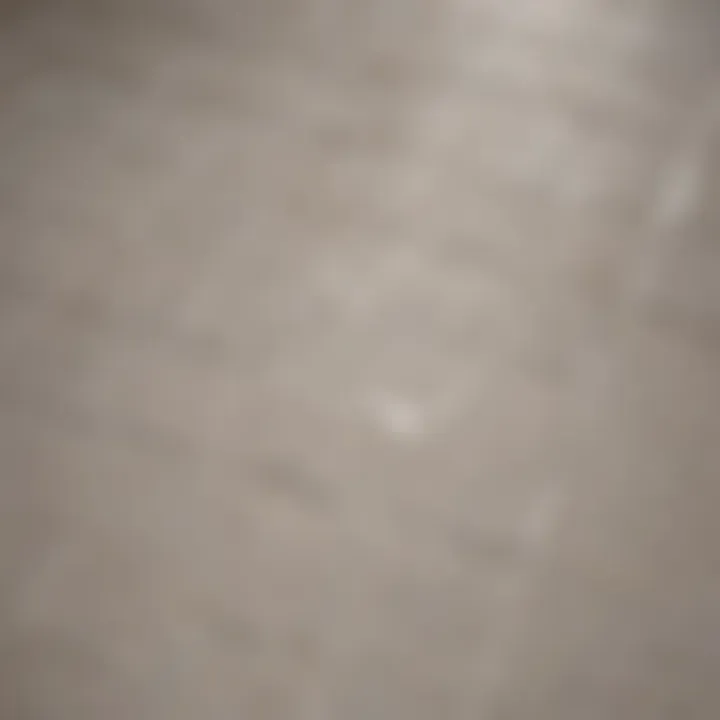
Common Problems with Grout
Maintaining grout can be challenging because it faces many common issues. One notable problem is mold growth, which thrives in damp environments. Mold can easily spread through the porous surface of grout, leading not only to unsightly stains but also to potential health hazards. Another problem is discoloration due to dirt buildup or improper cleaning solutions.
Additionally, that grout can crack over time, especially in areas with heavy foot traffic or exposure to water. Cracked grout may allow water penetration below the surface, which can cause further damage to the underlying structure. Regular maintenance is essential to prevent these issues from becoming severe, and utilizing effective cleaning methods, like bleach, can combat these common grout problems efficiently.
Rationale for Using Bleach
Bleach has long been recognized as a powerful cleaning agent, and its application in grout cleaning is particularly prevalent. Grout, often forming the seams between tiles, can be a breeding ground for germs, mold, and mildew. Therefore, understanding the rationale for using bleach can aid in not only maintaining the aesthetic appeal of tiled surfaces but also in promoting a healthier living environment.
The importance of bleach in grout cleaning stems from its potent disinfecting properties. Bleach is effective in breaking down tough stains and eliminating bacteria, making it an ideal choice for maintaining the cleanliness of grout lines. The ability to sanitize surfaces is especially valuable in areas like kitchens and bathrooms, where hygiene is critical.
Furthermore, the cost-effectiveness of bleach cannot be underestimated. Unlike some specialized cleaners, bleach is readily available and inexpensive. This makes it accessible for many households, providing an affordable solution to a common problem.
There are also specific considerations to keep in mind when using bleach. While it is effective, it may not be suitable for all types of grout or tiles. Care must be taken to ensure that the surfaces being treated are compatible with bleach to avoid damage. Additionally, safety precautions must be observed, as bleach can be harmful if not used properly.
In summary, the rationale for using bleach in grout cleaning lies in its effectiveness as a disinfectant, availability, and cost benefits. Yet, being mindful of safety and compatibility is crucial in its application.
Chemical Properties of Bleach
Bleach, primarily composed of sodium hypochlorite, is a strong chemical widely used for cleaning and disinfection. It works by releasing chlorine, which is a powerful oxidizing agent. This chemical reaction allows bleach to break down organic material, making it effective against stains caused by mold and mildew. The ability to penetrate porous surfaces like grout means that bleach can reach deep down, targeting the root of the stains.
The pH of bleach also plays a role in its effectiveness. When diluted appropriately, bleach maintains an alkaline environment that enhances its cleaning power. This balance is necessary for maximizing stain removal without risking damage to the grout itself.
Effectiveness against Mold and Mildew
Mold and mildew thrive in damp environments, making grout a prime target. Bleach is effective against both because it not only cleans but also kills the spores that lead to regrowth. When applied correctly, bleach can eliminate these harmful microorganisms, helping to keep your home healthier.
Testing has shown that a solution of bleach can reduce mold colonies significantly. This makes it an appropriate choice for homeowners dealing with persistent mold issues. However, it's essential to note that while bleach can kill visible mold, it does not remove the underlying causes of moisture that allow mold to thrive.
Bleach Concentration and Its Impact
The concentration of bleach used is critical for both safety and effectiveness. Most cleaning solutions suggest using a bleach-to-water ratio of about one part bleach to ten parts water for general cleaning purposes. This dilution helps to minimize the risk of damage to surfaces while still providing sufficient cleaning power.
Using a higher concentration does not always equate to better results. In some cases, it can lead to surface damage or skin irritation. It is recommended to use the appropriate concentration for specific cleaning tasks to balance efficacy with safety.
"Diluting bleach properly maximizes cleaning efficiency while minimizing risks."
When working with bleach, proper measurements and awareness of the intended application can significantly influence the results. Keeping track of concentrations helps avoid excess use, which not only preserves the integrity of the grout but also protects the health of the individuals performing the cleaning.
Safety Precautions When Using Bleach
When utilizing bleach for grout cleaning, safety precautions are paramount. While bleach is effective in removing stains, mold, and mildew, its corrosive nature can pose risks if mishandled. Ignoring safety can lead to severe health issues and damage to your surroundings. Hence, understanding and implementing safety measures is crucial.
Personal Protective Equipment (PPE)
Before starting the cleaning process, it is essential to equip yourself appropriately. Personal Protective Equipment (PPE) acts as a barrier against harmful substances. Here are key items you should consider wearing:
- Gloves: Use rubber or latex gloves to protect your hands from direct contact with bleach. Prolonged exposure can lead to skin irritation or burns.
- Goggles: Eye protection is critical. Bleach can irritate or damage the eyes, so wearing goggles ensures safety from splashes.
- Mask: A mask or respirator can help filter out harmful fumes. Bleach vapors can irritate respiratory systems or trigger allergic reactions.
By donning suitable PPE, you mitigate the risks associated with bleach, allowing you to focus on the task at hand while remaining safe.
Proper Ventilation Techniques
Good ventilation is vital when working with bleach. Insufficient airflow can cause fumes to accumulate, increasing the risk of inhalation. Here are steps to ensure proper ventilation:
- Open Windows and Doors: Start by airing the space where you'll be cleaning. Fresh air reduces fume concentration.
- Use Fans: Positioning fans can help circulate air. Directed airflow enhances the speed at which fumes disperse.
- Avoid Closed Spaces: If possible, do not clean in confined areas without ventilation. For example, avoid cleaning bathrooms without a window open or ventilation fan running.
Improving ventilation protects you from the harmful effects of inhaling bleach fumes, creating a safer working environment.
Signs of Chemical Sensitivity
Being aware of your body’s reactions while using bleach is crucial. Some individuals may experience chemical sensitivity even with minimal exposure. Watch out for the following signs:
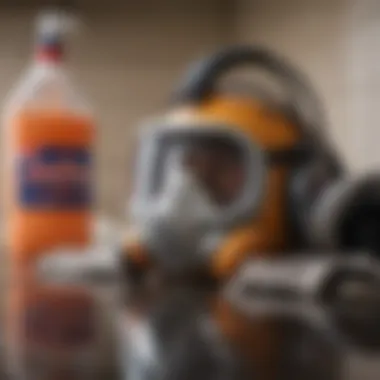
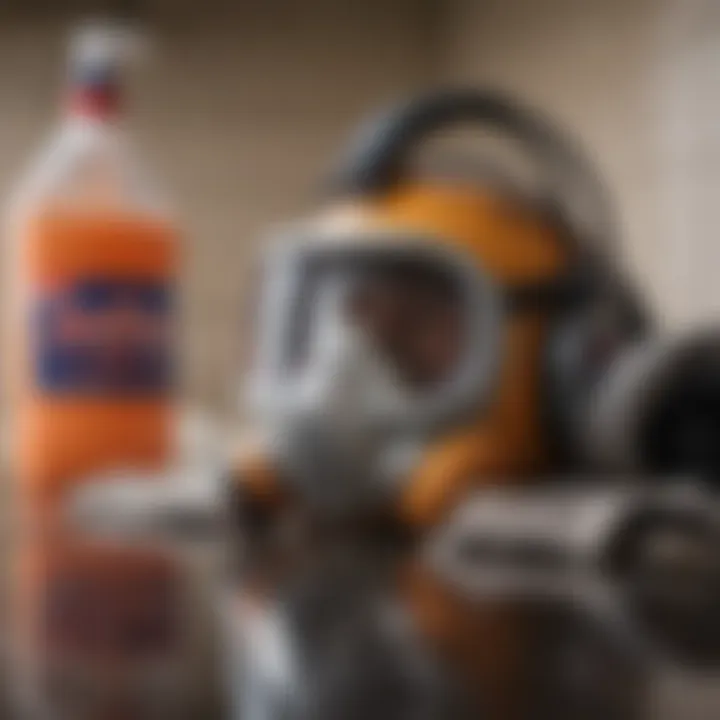
- Breathing Difficulties: Shortness of breath, wheezing, or coughing can indicate a reaction to bleach fumes.
- Skin Reactions: Redness, itching, or burning sensations on skin can result from contact with bleach.
- Nausea or Headaches: If you begin to feel dizzy, lightheaded, or nauseous, it may be a sign of excessive exposure to fumes.
If you experience any of these symptoms, stop using bleach immediately and move to fresh air. Notify a healthcare professional if symptoms persist. Awareness of chemical sensitivity ensures a prompt response, safeguarding your health while cleaning.
Preparing a Bleach Solution
Preparing a bleach solution is a critical step for effective grout cleaning. The right concentration can enhance the cleaning process, making it both safe and efficient. This section details the proper methods for creating a bleach solution that will tackle stubborn grout stains, while also providing important considerations.
Ideal Ratios for Bleach and Water
The ideal ratio of bleach to water is essential for achieving optimal results. A common mixture is one part bleach to ten parts water. This translates to roughly 1 cup of bleach mixed with 10 cups of water. At this concentration, it effectively kills mold, mildew, and other pathogens without being overly harsh.
- Precision is Key: Use measuring instruments to ensure accuracy. Over-concentration can damage grout or tiles.
- Mix Thoroughly: Ensure the bleach is well integrated into the water. Stir gently to blend the solution, as shaking can cause bubbles.
- Storage: If you prepare more solution than needed, store it in a labeled, closed container. However, always use it within a few days for maximum effectiveness.
Alternative Additives to Enhance Effectiveness
For those seeking to boost the cleaning power of their bleach solution, certain additives can be helpful. Adding a few common ingredients can enhance its disinfecting properties without compromising safety.
- Dish Soap: A couple of drops can increase the solution's cling. This allows it to remain on vertical surfaces longer, maximizing contact time with the grime.
- Baking Soda: This can provide mild abrasiveness, which helps in scrubbing tougher stains. Mixing a tablespoon of baking soda into the solution can offer a boost in cleaning power.
- Vinegar: While vinegar reacts with bleach, using it separately before the bleach application can prepare the surface by breaking down mold. Just ensure they are not mixed directly, as this will create harmful fumes.
When preparing a bleach solution, be mindful of these ratios and additives. This knowledge will allow your grout cleaning efforts to be both effective and safe.
Applying Bleach to Grout
Applying bleach to grout is significant in the context of home cleaning. Grout can harbor mold, mildew, and stains, which not only affect appearance but also may cause health concerns. Bleach is recognized for its properties that break down these contaminants effectively. The process of application is essential, as it ensures thorough cleaning while minimizing potential damage to surrounding areas. A well-executed application can enhance the lifespan and appearance of grout, making it a worthwhile endeavor for homeowners.
Tools Required for Application
To ensure an effective grout cleaning process using bleach, it is important to gather the right tools. Here are some necessary items:
- Small Bucket: For mixing bleach with water.
- Sponge or Soft Brush: An effective tool for scrubbing grout lines without damaging the tile.
- Spray Bottle: Enables easy and even application of the solution on larger areas.
- Old Toothbrush: Great for getting into tight spaces and difficult stains.
- Protective Gear: Such as gloves and eyewear, to avoid skin or eye irritation from bleach.
- Mop or Cloth: For rinsing and drying the area post-application.
Having these tools at hand simplifies the cleaning process and enhances efficacy by allowing for detailed work on grout surfaces.
Step-by-Step Application Process
The method of applying bleach to grout requires attention to detail. Follow these steps for effective cleaning:
- Preparation: Ensure the area is free of large debris. Sweep or vacuum prior to cleaning.
- Mix the Solution: Combine bleach and water in a small bucket. A common ratio is one part bleach to ten parts water, but adjust based on the level of staining.
- Apply the Solution: Using a sponge or spray bottle, apply the bleach solution directly to the grout lines.
- Soak: Let the solution sit for at least 10 to 15 minutes. This time allows bleach to work on the mildew and stains.
- Scrub: With a soft brush or toothbrush, scrub the grout gently to lift stains. Pay attention to areas with more visible dirt.
- Rinse: After scrubbing, rinse with clean water to remove bleach residues. Proper rinsing is vital to prevent potential damage to the grout or surrounding surfaces.
- Dry: Finally, use a cloth or mop to dry the area. This step is important to avoid any moisture-related issues post-cleaning.
Remember, the effectiveness of bleach diminishes with extended exposure to air, so prepare just enough for your cleaning session.
Time Management During Application
Time management is critical during the cleaning process. Allocate time based on the condition of the grout. Here are some tips:
- Quick Assessment: Before starting, assess the extent of staining or dirt. Planning your approach can save time later.
- Breakdown Tasks: Consider dividing larger areas into sections. Focus on one section at a time to maintain efficiency.
- Use a Timer: Setting a timer ensures you don’t exceed soaking times and remain on track during rinsing.
- Clean Regularly: Frequent cleaning intervals can reduce the time needed for each application, as stains will not set in deeply.
By managing your time effectively, you can ensure a smooth and efficient cleaning process that maximizes the benefits of applying bleach to grout.
Post-Cleaning Maintenance
After employing bleach to clean grout, post-cleaning maintenance becomes crucial. This phase ensures that the newly cleaned surfaces remain in good condition and help extend the life of the grout. Proper maintenance is not simply about rinsing off the bleach but also involves a series of actions that can prevent future discoloration and staining.
Maintaining clean grout can be both aesthetically pleasing and functionally beneficial. Clean grout not only contributes to the overall appearance of tiled surfaces but also minimizes the chances of mold and mildew development. Additionally, effective maintenance reduces the need for frequent deep cleaning, saving both time and resources.
Rinsing Properly After Application
Rinsing is an essential step following the application of bleach. When bleach is used on grout, it is vital to thoroughly rinse the area afterward to remove any residual chemicals. Failing to do so can lead to a few potential issues:
- Deterioration of Grout: Residual bleach can weaken the grout over time, causing it to crack or crumble.
- Discoloration: Leftover bleach may cause discoloration, particularly on darker or colored grout, leading to unsightly patches.
- Chemical Fumes: Untreated residue can emit harmful fumes, especially in confined spaces, posing health risks.
To rinse effectively, use warm water and a clean sponge or cloth. Begin at one end and work your way across the tiled surface, ensuring each section is thoroughly washed. Repeat the process multiple times, using clean water for every rinse to avoid redistributing the bleach.
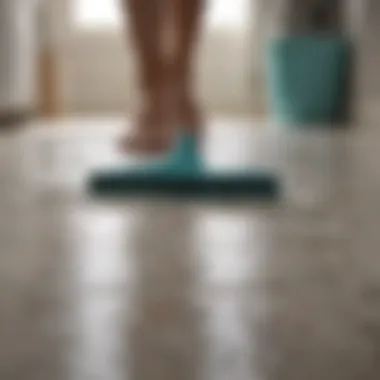
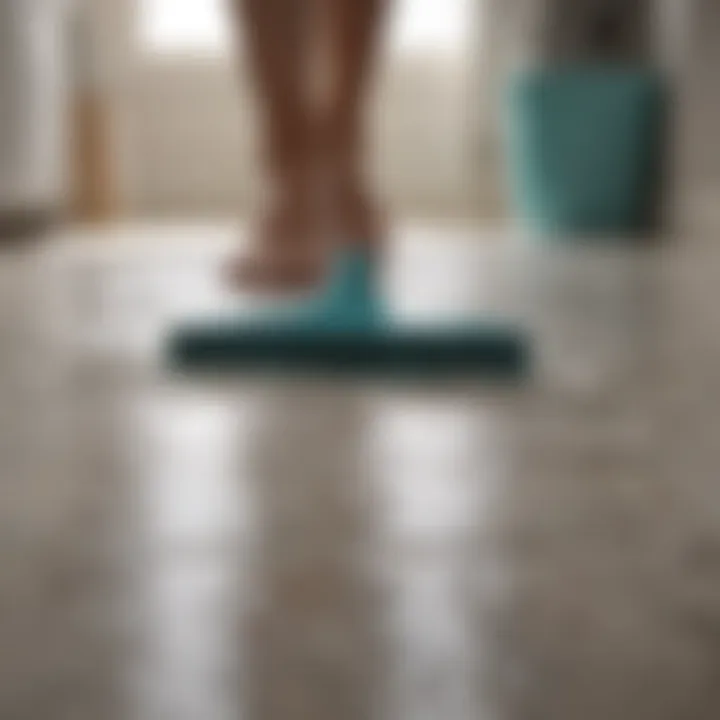
Identifying Residual Bleach Damage
After the cleaning and rinsing process, monitoring for any residual bleach damage is essential. Recognizing such damage can aid quick remedial actions. There are several signs to watch for:
- Color Changes: Noticeable fading or discoloration on the grout surface can indicate bleach lingering in the material.
- Cracks or Crumbling: If the grout begins to show cracks, it could be a sign that the material has been weakened by the bleach.
- Increased Porosity: Areas that feel more porous or crumbly are also indicative of bleach damage.
If you notice any of these signs, it might be necessary to re-grout or apply a sealant to restore the grout’s integrity. Regular checks can also help in maintaining the overall health of the grout.
"Post-cleaning maintenance is as important as the cleaning process itself. It guarantees longevity and aesthetic appeal."
In summary, effective post-cleaning maintenance strengthens grout and contributes to the longevity of tiled surfaces. Take time to rinse thoroughly and watch for any damage to avoid future complications.
Alternatives to Bleach for Grout Cleaning
When it comes to maintaining the cleanliness of grout, many people automatically reach for bleach. However, there are alternatives worth considering. These alternatives may be gentler on surfaces, less harmful to health, and better for the environment. Exploring these options aids in understanding how to effectively clean grout without the downsides of bleach. Let's take a closer look at the specific alternatives available, as well as their benefits and considerations.
Natural Cleaning Agents
Natural cleaning agents can provide an effective and eco-friendly way to clean grout. Common ingredients include vinegar, baking soda, and hydrogen peroxide. Each has its unique properties:
- Vinegar: Acetic acid in vinegar helps to break down dirt and grime. When mixed with baking soda, it becomes a potent cleaning agent.
- Baking Soda: Its mildly abrasive nature allows it to scrub away tough stains without scratching tiles. It also deodorizes, leaving spaces smelling fresh.
- Hydrogen Peroxide: This compound works as an oxidizing agent. It effectively disinfects surfaces and can brighten grout, restoring some of its original color.
Using these natural agents often involves mixing simple compounds. For instance, a paste of baking soda and water can be applied to stained grout, left to sit, and then scrubbed away. The simplicity and safety of these solutions make them appealing for parents and households aiming to maintain a clean yet safe environment for children.
Commercial Cleaning Products Compared
If natural agents do not meet cleaning needs, there are commercial products available formulated for grout cleaning. Some brands specialize in grout cleaners that are designed to penetrate the porous surface of grout, removing stains and killing mold effectively. Popular products include:
- Zep Grout Cleaner: Effective for removing stains and dirt while tackling mildew.
- CLR Clean-Up: This product targets calcium, lime, and rust deposits, useful where mineral buildup is an issue.
- OxiClean MaxForce: It uses oxygen-based technology to lift stains from grout effectively.
When comparing commercial products, consider the following:
- Effectiveness: Check user reviews and effectiveness ratings to ensure the product meets your specific needs.
- Safety: Many products contain chemicals, so it’s critical to read labels carefully for safety information, especially if there are children or pets in the home.
- Environmental Impact: Some brands focus on eco-friendliness, which may align better with consumers' values.
Environmental Considerations
Understanding the environmental considerations when using bleach as a grout cleaning agent is vital. This section focuses on the broader implications of using bleach, particularly regarding indoor air quality and sustainable cleaning practices. Awareness of these factors helps individuals make informed choices that can yield cleaner surfaces while minimizing negative effects on health and the environment.
Impact of Bleach on Indoor Air Quality
The use of bleach can significantly impact indoor air quality. When bleach is applied, it releases chlorine vapors, which can irritate the eyes, skin, and respiratory system. This is especially concerning in poorly ventilated areas where the fumes can accumulate. Individuals may experience symptoms like headaches, breathing difficulties, or exacerbated allergies. Families with children or pets should be particularly cautious since young lungs are more vulnerable to such irritants.
Proper ventilation during and after cleaning is essential. Open windows and utilize exhaust fans to help dissipate fumes. Consider the concentration used. Higher concentrations can lead to more potent vapors, increasing risk. The timing of application also plays a role. Using bleach during off-peak hours allows the indoor air to clear before entering the space again. Ultimately, understanding these implications is crucial for safeguarding health while maintaining clean grout.
Eco-friendly Grout Cleaning Practices
Alternatives to bleach are available for those who prioritize sustainability and environmental health. Many natural cleaning agents can effectively clean grout without harming indoor air quality or contributing to chemical waste. Consider using white vinegar or baking soda instead. These substances are less harmful and biodegradable, making them better for the environment.
Some eco-friendly practices include:
- Diluting cleaning solutions: Using less concentrated solutions can mitigate harmful effects while still providing cleaning benefits.
- Opting for biodegradable products: Many commercial cleaners now offer eco-friendly lines that are effective yet safe for both users and the environment.
- Using steam cleaning: This method requires only water and provides effective cleaning through high temperatures, eliminating the need for chemical agents.
Thinking about the choices we make in cleaning practices highlights the importance of balancing efficacy with environmental responsibility.
"By understanding the impact of cleaning agents like bleach, we are empowered to make choices that benefit both our homes and the planet."
Summary and Recommendations
In the realm of grout cleaning, utilizing bleach stands out as a practical and effective solution. The purpose of this section is to synthesize the content discussed in earlier parts of the article while providing actionable recommendations for maintaining clean grout. A cleaner grout not only improves home aesthetics but also contributes to a healthier living environment by reducing mold and mildew presence. This section emphasizes the significance of taking informed approaches when using bleach, alongside maintaining overall grout hygiene.
Useful Tips for Maintaining Clean Grout
Keeping grout clean can sometimes feel overwhelming. However, some simple practices can make a significant difference. Here are a few effective strategies:
- Regular Cleaning: Set a routine for cleaning grout with a mild solution, such as vinegar and water. This helps in preventing build-up.
- Sealing Grout: After deep cleaning, consider applying a quality sealer. This can protect the grout from moisture and stains.
- Avoid Harsh Chemicals: While bleach is effective, frequent use can weaken grout. Alternative natural cleaners can be less abrasive and include ingredients like baking soda or lemon juice.
- Quick Wipe-ups: Immediately address spills or discolorations. This helps in preventing stains from setting into the grout.
When to Seek Professional Help
While many cleaning tasks can be managed independently, sometimes professional intervention is necessary. Here are instances when it's wise to consider hiring experts:
- Severe Stains or Discoloration: If stains persist despite multiple cleaning attempts, professionals have access to advanced tools and cleaners that can restore grout.
- Mold Infestation: Chronic mold issues can pose health risks. Professional cleaners can assess and treat mold effectively to ensure comprehensive removal.
- Damaged Grout: If the grout exhibits cracks or deterioration, it may require repair or replacement, which is best handled by professionals experienced in flooring upkeep.
- Time Constraints: For busy parents or individuals, sometimes it's more efficient to hire professionals rather than attempting to manage grout cleaning on one’s own.



